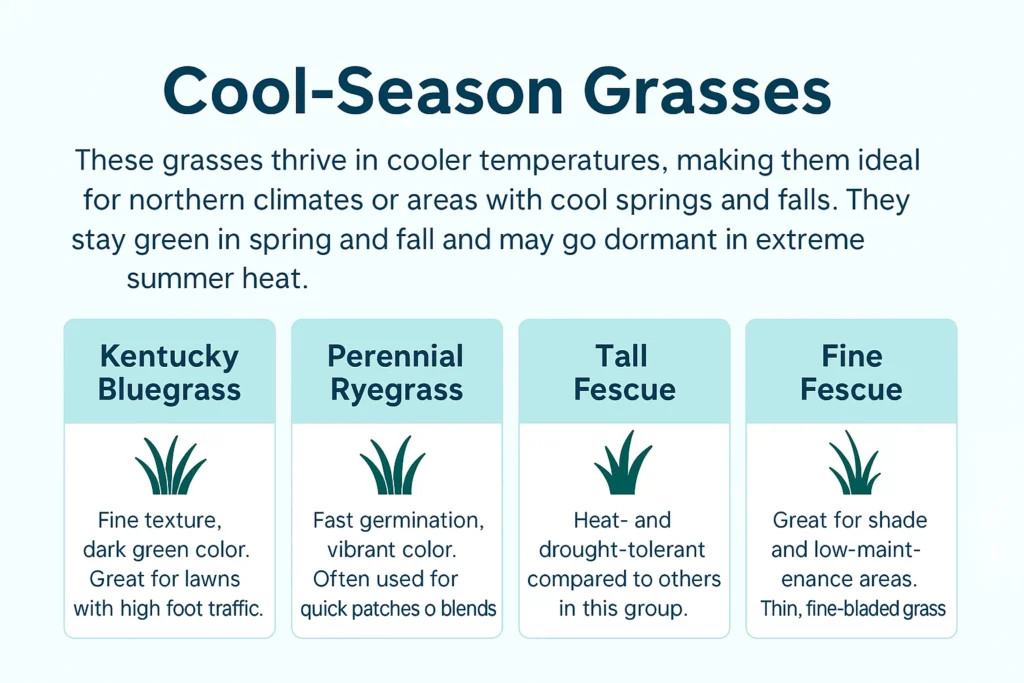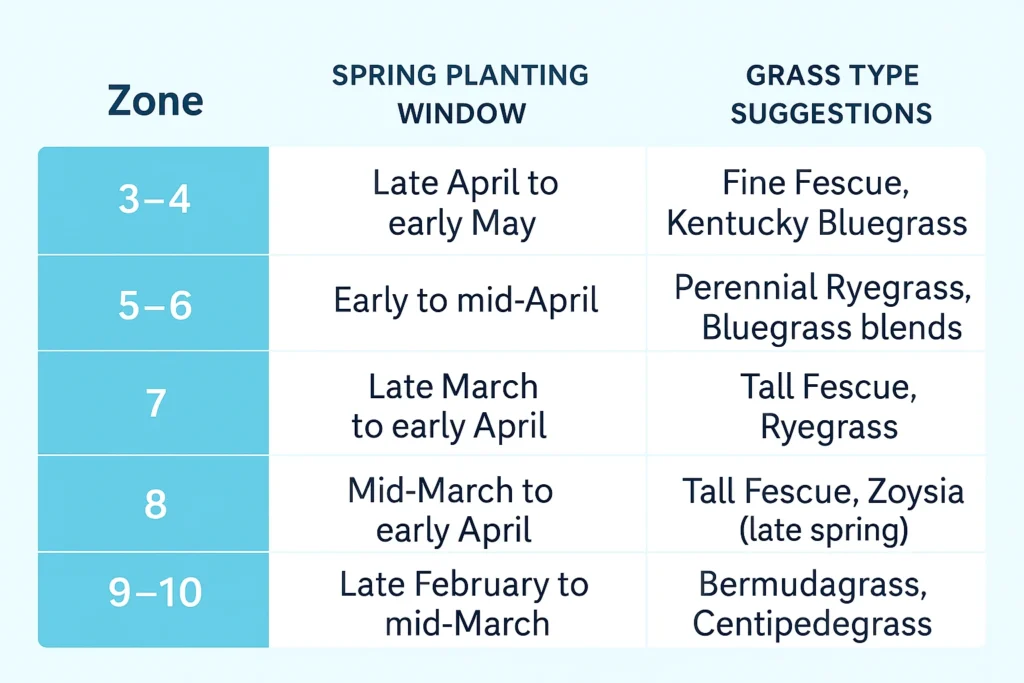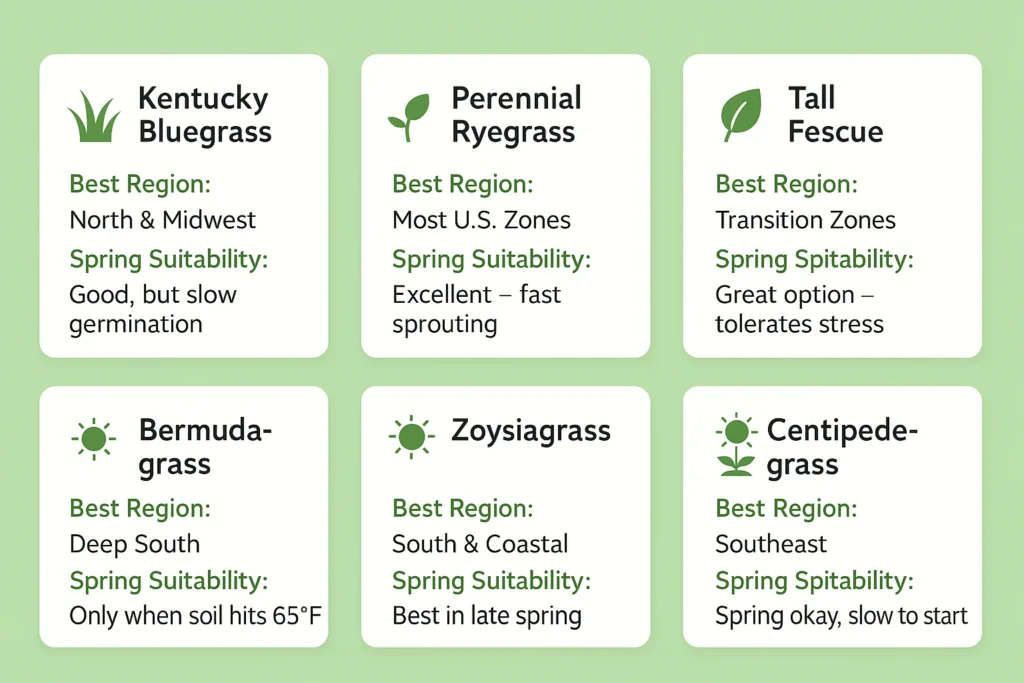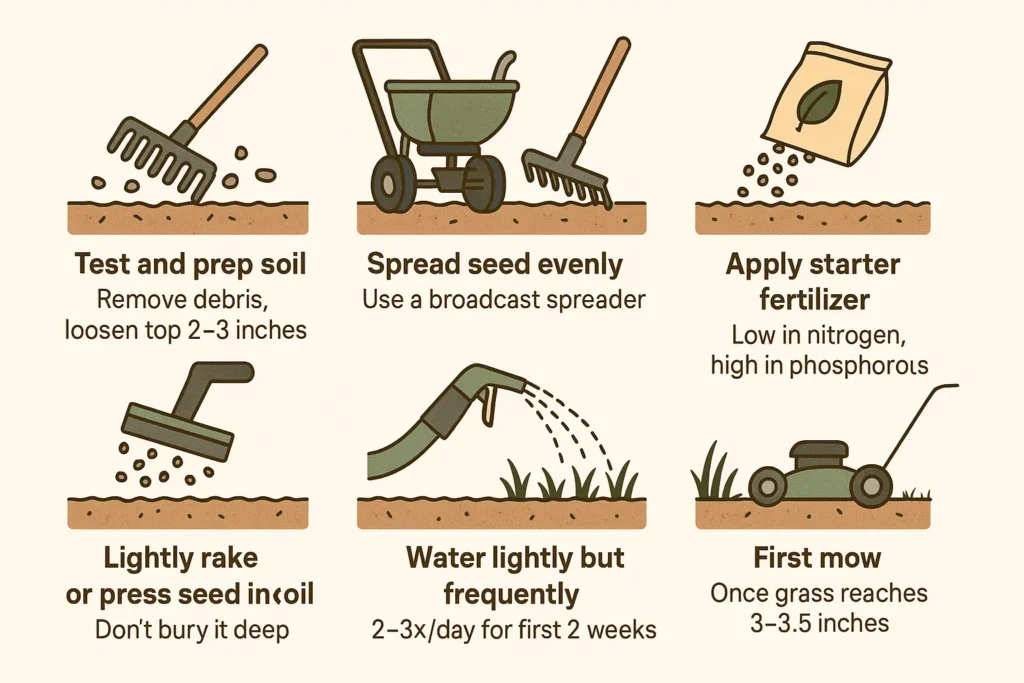When to Plant Grass Seed in Spring: A Complete Guide by Region & Grass Type

Planting grass seed in spring is a decision that walks a fine line. Get it right, and you’ll set your lawn or landscape up for a full season of growth. Get it wrong, and you’ll spend your summer playing catch-up. In this guide, we’ll walk through which grasses work best for spring sowing, the timing by region, how to handle the variables (like temperature swings and soil prep), and mistakes you’ll want to sidestep.
If you’re looking for a complete walkthrough on when to plant grass seed in spring — from grass types to zone-based calendars — this guide is for you.
Table of Contents
Cool-Season Grasses: Built for the Chill, Thrive in Spring
Before we talk dates or tools, let’s get to know the grasses. Cool-season grasses are your go-to if you’re in the northern half of the U.S. These varieties grow best when soil temps sit between 50°F and 65°F — which often lines up with early to mid-spring in many states.
Kentucky Bluegrass is one of the most popular choices. It forms a dense, green lawn but takes time to establish. Spring is a fair time to plant it, though fall remains ideal.
Perennial Ryegrass germinates fast — often within 5 to 10 days. It’s perfect if you need quick cover or are overseeding patchy areas in spring.
Tall Fescue brings heat tolerance and drought resistance to the table. It’s a reliable spring performer, especially in transition zones.
Each of these cool-season grasses benefits from spring planting, though it’s important to get seed in early enough to avoid the stress of summer heat.
Warm-Season Grasses: Spring Is Just the Start
Warm-season grasses, like Bermudagrass, Zoysiagrass, and Centipedegrass, prefer soil temps in the 65°F to 75°F range. These types go dormant in winter and really get moving in late spring through summer.
Bermudagrass grows aggressively and thrives in southern states. It needs warm soil and full sun, making late spring the earliest point you’d want to plant.
Zoysiagrass takes longer to germinate but rewards patience with a dense, carpet-like lawn. Spring planting is ideal, but only once the soil has fully warmed.
Centipedegrass is low-maintenance and slow-growing. Spring is a good window, but again, don’t rush it — wait until frost is no longer in the rearview.
Planting warm-season grass seed in spring means watching soil temps closely. The calendar is helpful, but your soil thermometer will be your best friend.
Is Spring a Good Time to Plant Grass Seed?
When to plant grass seed in spring depends heavily on your local conditions. In general, yes — spring can be a great time. But it’s not as forgiving as fall for cool-season types, and it demands close attention for warm-season grasses.
✔ Pros of Spring Seeding
- Spring rains reduce the need for constant watering
- Cool-season grasses start strong and establish roots early
- You can fix bare spots before summer traffic hits
✘ Cons of Spring Seeding
- Germinating seedlings can struggle as heat ramps up
- Weed competition is tougher in spring
- Timing is tighter — too early is cold, too late is hot
The sweet spot is when your soil has thawed, is workable, and daytime highs consistently sit between 60°F and 75°F.
When to Plant Grass Seed in Spring by USDA Planting Zone?
If you’re not sure exactly when to plant grass seed in spring, using your USDA hardiness zone is one of the simplest ways to time it right. These zones are based on average low winter temperatures and offer a helpful window into when your soil is warm enough for grass seed to germinate.
🔍 Not sure what zone you’re in? You can look up your zone here.
✅ Pro tip: Soil temperature is more important than air temperature. For cool-season grasses, wait until soil hits 50°F. For warm-season grasses, 65°F is your magic number.
Including zone-based timing ensures that your approach to planting grass seed in spring is tuned to your local climate, not just a generic date. For even more accuracy, pair your zone lookup with a simple soil thermometer and watch your weather patterns.
Best Regions to Plant Grass Seed in Spring
Northern & Midwest States
Window: Mid-Mar to Mid-May
Focus: Bluegrass, Fescue, Ryegrass
Watch: Late frosts
Transition Zones
Window: Late Mar to Late Apr
Fescues thrive; Zoysia possible if warm
Southern States
Window: Late Apr to Early Jun
Bermuda & Centipede like warm soil
Don’t plant too early—nights stay cool
When to plant grass seed in spring varies by region. Here’s a basic breakdown:
Northern & Midwest States
- Best window: Mid-March to Mid-May
- Focus on: Kentucky Bluegrass, Fescue, Ryegrass
- Watch out for: Late frosts
Transition Zones
- Best window: Late March to Late April
- Fescues do well, but early-season Zoysia is possible if soil warms up quickly
Southern States
- Best window: Late April to Early June
- Warm-season seeds like Bermuda and Centipede prefer warmer soil
- Avoid planting too early — spring nights can still dip too low
Use a soil thermometer — aim for 50°F for cool-season grasses, 65°F+ for warm-season varieties.
Grass Types That Grow Well When Planted in Spring
When to plant grass seed in spring also depends on which seed you’re using. Here’s a quick rundown by type:
Kentucky Bluegrass
Best for: Northern and Midwest lawns
Kentucky Bluegrass is the classic cool-season choice — lush, dense, and deep green. It spreads by underground rhizomes, which makes it great for filling in gaps. Spring planting is a decent option, though it germinates slowly (14–30 days), so early timing is key. You’ll need patience and consistent moisture to help it along.
Perennial Ryegrass
Best for: Most U.S. zones
If you need quick results, perennial ryegrass delivers. It germinates in as little as 5 days and is ideal for overseeding or patching up winter damage. It prefers cooler climates but works in a wide range of zones. When to plant grass seed in spring? For ryegrass, you can start as soon as soil temps hit 50°F — it won’t make you wait.
Tall Fescue
Best for: Transition zones and anywhere with heat swings
Tall fescue is tough. It has deep roots that handle drought, summer heat, and even some shade. Spring planting works well — just try to get it in early so it’s established before the hot months arrive. It germinates faster than bluegrass but slower than rye.
Bermudagrass
Best for: The Deep South
Bermuda is a warm-season warrior that grows fast and spreads aggressively. But it’s fussy about temperature. If you’re wondering when to plant grass seed in spring for bermuda, wait until the soil reaches at least 65°F. Too early and it’ll sit dormant — or worse, rot. Late spring is usually the safer bet.
Zoysiagrass
Best for: Southern and coastal regions
Zoysia builds a dense, plush lawn that crowds out weeds. It’s slow to establish from seed but worth the wait. Spring is a good time to start — as long as the soil is warm and consistent sun is available. This isn’t a grass you rush. For better results, plant it in late spring or early summer when temperatures are stable.
Centipedegrass
Best for: The humid Southeast
Centipedegrass is low-maintenance and slow-growing, making it a great pick for folks who don’t want to mow every weekend. It can be planted in spring, but like other warm-season grasses, it needs soil temps above 65°F. It’s not fast, so don’t expect an instant lawn — just steady progress with a light touch.
Check out our full regional seeding guide: Best Time to Plant Grass Seed (Guide)
Tips for Planting Grass Seed in Spring
When to plant grass seed in spring is half the story — what you do during planting matters just as much.
Timing
- For cool-season grasses: plant as soon as soil is thawed and workable
- For warm-season grasses: wait until nighttime lows stay above 60°F
Soil Prep
- Test your soil (pH 6.0–7.0 is ideal)
- Loosen compacted areas with a rake or aerator
- Rake in a thin layer of compost before seeding
Watering
- Water lightly 1–2 times per day until germination
- Keep the top 1/2 inch of soil moist — not soggy
Covering the Seed
- Use straw or mulch to hold moisture and prevent erosion
- Don’t bury the seed — light contact with soil is best
What to Avoid
- Overseeding right before a heavy rain
- Using weed killers too early — wait 6 weeks post-germination
- Planting too late in spring when heat stress will hit young grass
Mistakes to Avoid When Seeding in Spring
Here’s where spring seeding often goes sideways:
- Planting too shallow or too deep: Aim for ⅛ to ¼ inch depth
- Not watering enough: Seedlings die fast if they dry out
- Skipping seed-to-soil contact: Press seeds in gently with a roller or rake
- Using the wrong type of seed: Always match seed to your region and season
When to plant grass seed in spring also means knowing when not to — if you’re past the point of mild days and cool nights, it’s better to wait for fall or consider sod.
What If You Miss the Window?
If you’re reading this in late June, you’re probably too late for cool-season grass seed. You’ve got a few options:
- Try dormant seeding in late fall — seed over frozen ground before snow
- Consider sod or plugs for instant cover
- Wait for fall — a much more forgiving season for cool-season varieties
For warm-season grasses, late spring into early summer may still work — just monitor temps and moisture closely.
State-by-State Grass Seeding Guides
Looking for more specific advice? We’ve built regional planting calendars too:
- When to Plant Grass Seed in Michigan – Cool-season turf thrives in late summer to early fall
- When to Plant Grass Seed in Pennsylvania – Spring or fall planting depending on your zone
- When to Plant Grass Seed in Colorado – Tackle variable weather and dry conditions with timing tips
- When to Plant Grass Seed in Texas – Learn the best times for Bermuda, Zoysia, and more
- When to Plant Grass Seed in Ohio – Best practices for cool-season grasses in Midwest climates
- When to Plant Grass Seed in Illinois – Avoid windburn and frost with season-specific tips
- When to Plant Grass Seed in Georgia – Focus on warm-season varieties and irrigation timing
- When to Plant Grass Seed in Florida – Seeding around tropical rain patterns and heat
- When to Plant Grass Seed in California – Different zones mean different seeding calendars
- When to Plant Grass Seed in North Carolina – Tips for Piedmont, coastal, and mountain regions
- When to Plant Grass Seed in Tennessee – Regional breakdowns for transitional planting zones
Tools and Resources to Make Planting Easier
You don’t need to go it alone. Use these tools from our site to make smarter decisions:
- ✅ Grass Seed Calculator
- ✅ Lawn Fertilizer Calculator – Apply the right amount of nutrients based on lawn size and grass type
- ✅ Lawn Mowing Cost Calculator – Estimate mowing expenses by lawn size, frequency, and contractor pricing
- ✅ Lawn Care Cost Calculator – Budget for overseeding, watering, fertilizing, and more
These are especially useful when trying to figure out exactly when to plant grass seed in spring based on your local conditions.
And for expert-backed houseplant care tips, explore this guide from the Conservation Evidence on sowing grass seeds.
Final Thoughts
When to plant grass seed in spring isn’t just a calendar date — it’s about watching the soil, knowing your seed, and responding to the weather in real time. Spring is a great opportunity to build strong turf, whether you’re patching bare spots or laying down new growth. Just don’t wait too long, and follow through with watering and care.
Spring lawns aren’t made in a day, but they start with the right week. Plant smart — and your summer lawn will thank you.
Let me know if you’d like this as a downloadable .docx, formatted HTML, or adapted for your CMS.





